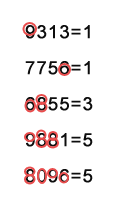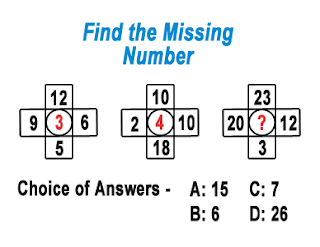A Problem With Puzzles
25 Feb 2012 Here's a puzzle, tweeted by AetherlingHave a go at it yourself. Solution below.
You see these sorts of puzzle every now and again. And there are usually common 'tricks' to them.
My first instinct was to add the digits. Nothing. Modulus? Nope. Sum and modulus, multiply digits, square, divide? Nope.
So, what?
For some reason, I decided I was going to try some algebra - ignore the fact that the left-hand sides of the equations are numbers, and treat them as variables with some unknown values. And then, add up whatever those values are to get the numbers on the right of the equations.
i.e. 9313 -> '9' + 2x'3' + '1' = 1; 1111 -> 4x'1' = 0; etc.
So from 1111=2222=3333=5555=7777=0 we get that 1,2,3,5,7 = 0
From 0000=6666=9999=4 we get that 0,6,9 = 1
And from 6855=3, 1+'8'=3 => 8=2
4 is undefined. And that makes the answer to the puzzle 2581=2.
It took me about half an hour to come up with that answer..
"If all you have is a hammer, everything looks like a nail"
That is the right answer. But the puzzle suggests that a preschooler would get the correct answer with ease. And I doubt a preschooler would do so with algebra.
So, what would a preschooler do? And why does it take 'higher educated' people so much longer?
What's the 'correct' answer? Take a look at the below
Basically, it's the number of loops in the digits on the left-hand side. This had to be pointed out to me by Aerliss.
But here's the interesting thing - take a look at the values I assigned to the number.
I got to the same answer, and effectively 'derived' the number of loops in the digits, without realising that that's what I was doing.
Source on the subheading quote - Maslow's Hammer.
It's not a perfect analogy, but the idea is this - the more mathematical training you have, the more techniques you'll be trying to use to solve the problem; possibly causing you to miss the 'obvious' answer. As, indeed, I did.
In this analogy, maths is the hammer.
And, strictly speaking, this puzzle isn't a maths problem - even though it's presented as if it were. And even though it can be solved using maths.
Another Problem
Here's another puzzle, recently posted on Reddit
The problem here is that the correct answer isn't known.
The 'obvious' answer (in as much as the one that most commenters came up with) was to add the four cross numbers, divide by 10, and round to the nearest whole number. In that case, the missing number is (23+20+12+3)/10 = 5.8 ~ 6 (B).
But that doesn't explain the set up - why the crosses? Are the positions of the numbers in the cross significant? And rounding is a little messy.
The most compelling proposed solution, once again, doesn't actually involve any maths:
"As far as I can tell, the answer is C: 7 [...] The formula for the number in the center is the number of unique letters shared by the top and bottom numbers as written in English plus the number of unique letters shared by the right and left numbers.."
Finite Rule Paradox
At any rate, what the comment thread shows is, in the absence of a 'true' answer, any answer is potentially correct with some valid justification. Case in point, I've just presented two different possible answers with two valid justifications.
This is an example of Wittgenstein's Finite Rule Paradox.
Stated explicitly - "This was our paradox: no course of action could be determined by a rule, because any course of action can be made out to accord with the rule"
Basically, what I described above..
There's a clearer explanation here. The topic is also a plot point in the novel (and subsequent film adaptation) The Oxford Murders; recommended if you're into maths-fueled murder mysteries.
The paradox is more apparent in 'find the next term in the sequence' puzzles.
For example, if you're given 2, 4, 8, 16 and asked what the next number is, then the obvious answer is 32 - twice the previous number/powers of two.
However, 31 is an equally valid continuation, as Marcus du Sautoy explains:
"[L]et me explain why 31 can be a perfectly legitimate way to continue the sequence 2, 4, 8, 16 ... Draw three dots on a circle and join the dots with lines. The circle gets divided into four pieces. If you now take four dots on the circle and draw all the lines between the dots then you cut the circle into eight pieces. Five dots leads to 16 pieces. But if you draw all the lines between six dots you will only get 31 pieces rather than the 32 you'd expect."
In fact, you can define a function, f(n), which satisfies the first 4 terms of the above sequence, and will give any number you like for the fifth.
The Easy Path
How is that possible? Lagrange Interpolation.
[Discussed in Professor Stewart's Hoard of Mathematical Treasures]
Lagrange interpolation applies to any (numerical) sequence of any (finite) length; so, there are infinitely many ways to continue any given sequence - and, necessarily, one cannot say with absolute certainty that a given sequence will continue in one particular way, only.
Unless the person who set the puzzle says otherwise. Because if it's their puzzle, they know what answer they're looking for. And if you try to score easy marks on an exam by citing Wittgenstein, you're probably going to fail.
Of course, Lagrange polynomials - although interesting that they exist - are likely to be the least interesting way to continue a sequence. Certainly, the equivalent Lagrange polynomial isn't as meaningful or interesting as the circle division sequence; even though they both give the same first 5 terms.
And a Lagrange polynomial will probably never be the most obvious/aesthetically pleasing solution.
"[H]e conjectured that, though in principle all answers were equally probable, there might be something engraved on the human psyche [...] which guided most people to the same place, to the answer that seemed the simplest, clearest or most satisfying. He was definitely thinking that some kind of aesthetic principle was operating a priori which only let through a few possible answers for the final choice." - The Oxford Murders, Chptr 9Though, as seen in the Reddit puzzle, the simplest answer isn't necessarily the most correct one.
There Must Be Another Way
The important thing is, the existence of Lagrange polynomials 'proves' the Finite Rule Paradox for numerical sequences.
By the same logic, there must exist some functions, f(a,b,c,d), which satisfy the first 20 equations in the first puzzle, but give some values other than 2 for the last. Or, multiple functions which do give 2, but by different methods to the correct one.
Of course, such functions aren't likely to be easy to find. Especially when there are 20 'initial rules' to satisfy. But the fact that there are finitely many rules means it's possible.
Not that counting loops, or manipulating letters count as mathematical functions. But the point still stands.
At any rate, the important thing to remember is not to get too obsessed with the consequences of the Finite Rule Paradox. Or you may end up trying to lobotomise yourself to prove a theory.
Oatzy.
[What comes next - 3, 3, 5, 4, 4, 3, 5, 5, 4, ?]


